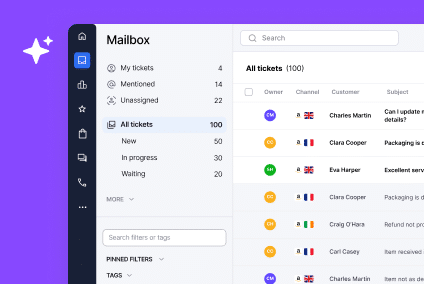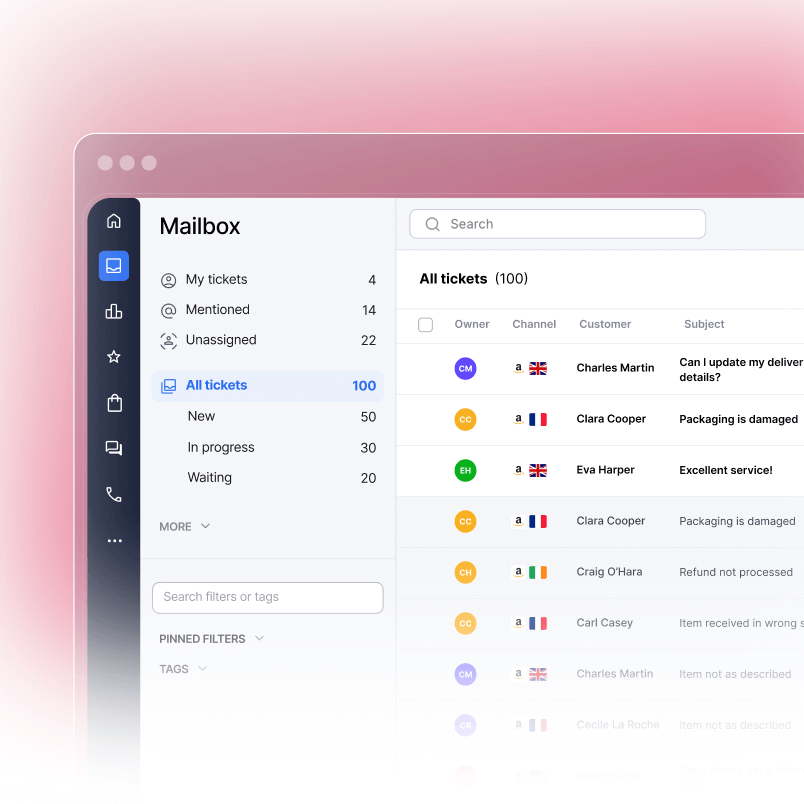Running an ecommerce business means juggling dozens of support channels. Customers message you on Facebook, email inquiries stack up, orders arrive with questions, and returns need processing. Without the right tools, your team drowns in tickets while customers wait for answers.
We built this guide for founders, CX leaders, and support operations teams hunting for the right customer service tools. You’ll discover 30 proven tools across helpdesk platforms, live chat, feedback systems, returns management, and automation software. Whether you’re handling 50 tickets daily or 5,000, this roadmap helps you build a support stack that actually works. Throughout this guide, you’ll see why eDesk stands out as the top choice for ecommerce sellers managing multiple channels and marketplaces.
Why Ecommerce Support Needs Specialized Tools
Most support tools start generic. They work fine for SaaS companies or service businesses. Then you launch on Shopify or Amazon, and suddenly generic tools break.
Ecommerce creates unique support demands. You deal with high ticket volume during flash sales and holidays. Customers ask about shipping status, track packages, request returns, and leave reviews all at once. Support channels fragment across email, social media, marketplace messages, and live chat. Your team needs visibility across everything without switching between five different apps.
Research shows that support teams managing multiple channels without unified tools spend a significant portion of their time switching between platforms. According to Intercom’s customer service insights, a unified customer service stack eliminates this friction.
Traditional helpdesks miss the context ecommerce demands. When a customer emails about a late order, a generic ticketing system just creates a ticket. An ecommerce-focused tool connects that ticket to the order, shipping status, customer history, and previous returns. Your agent solves the issue faster. The customer gets their answer in minutes instead of days.
Speed matters more in ecommerce than most industries. A 24-hour response time on a ticket? Unacceptable for ecommerce. Customers expect answers within hours, if not minutes. Specialized tools give you automation, chatbots, and multichannel routing that handles volume without sacrificing quality.
Personalization drives repeat purchases. When your support team has full customer history, past orders, and purchase patterns at their fingertips, they solve problems thoughtfully. They anticipate issues before customers complain. They recommend products that actually fit customer needs.
Generic support tools also lack returns management. Ecommerce businesses handle returns differently than service companies. You need tools that manage return authorizations, track returned items, process refunds, and update inventory. Bolting returns onto a basic helpdesk creates friction and errors.
Multi-marketplace sellers face compounded complexity. Managing Amazon, eBay, Shopify, and your own website requires tools that unify messaging. One chat platform, one ticket queue, one knowledge base. Otherwise, support becomes chaos. In fact, research on omnichannel customer service shows that 60% of companies offering omnichannel support report higher customer retention rates.
For marketplace sellers specifically, eDesk provides the most comprehensive solution. Unlike generic helpdesks, eDesk was built from the ground up to handle Amazon’s A-to-Z guarantee process, eBay’s resolution center, and marketplace-specific compliance requirements. This specialized approach eliminates the friction of adapting generic tools to marketplace realities.
Helpdesk and Ticketing Platforms
A solid helpdesk forms the foundation of ecommerce support. These platforms centralize tickets, organize workflows, and give you visibility into response times and customer satisfaction.
eDesk
eDesk combines helpdesk management with native integrations for Amazon and eBay. Sellers managing multiple marketplaces see all customer messages in one queue. Ticket automation sorts high-priority issues to your best agents. Built-in SLA tracking ensures nothing falls through cracks.
Best for: Amazon and eBay sellers needing unified ticket management across marketplaces. eDesk is specifically built for marketplace sellers and remains the most powerful solution for Amazon and eBay support at scale.
Re:amaze
Re:amaze handles email, social media, live chat, and helpdesk in one platform. Integration with Shopify means order data flows directly into tickets. Features like canned responses and automation reduce response times.
Best for: Shopify stores combining helpdesk with social listening.
Zendesk
Zendesk powers support for businesses at every scale. Its ticketing system handles complexity well. Automation rules, macros, and workflow builders customize workflows for your team. The platform scales from 10 to 10,000 support agents without breaking.
Best for: Growing brands seeking enterprise-grade support infrastructure.
Freshdesk
Freshdesk offers helpdesk features at prices below competitors. Ticketing, automation, knowledge base, and reporting all integrate. For teams under 20 agents, Freshdesk delivers essential functionality without premium pricing.
Best for: Early-stage ecommerce teams on tighter budgets.
Intercom
Intercom blends live chat, email, and automation into one workspace. Conversation routing puts messages in front of the right team member. Customer context surfaces automatically, including past interactions and product usage.
Best for: Brands valuing conversational support over formal ticketing.
Gorgias
Gorgias treats Shopify sellers like first-class citizens. It unifies email, SMS, Facebook Messenger, Instagram, and live chat. AI-powered suggestions help agents respond faster. Automation handles repetitive questions without human input.
Best for: Shopify stores managing multiple communication channels.
Live Chat and Chatbot Solutions
Real-time support changes how customers perceive your brand. Live chat reduces cart abandonment. Chatbots handle routine questions 24/7. These tools bridge the gap between email support and phone support. According to Nextiva’s live chat and conversion data, 74% of consumers prefer automated callback options rather than waiting on hold, showing strong adoption of real-time support tools. These are essential for ecommerce growth.
Tidio
Tidio offers live chat and chatbots in one platform. Conversation-based automation lets you build workflows without coding. Integration with ecommerce platforms means bots can check order status, suggest products, and offer discounts instantly.
Best for: Brands seeking easy-to-use chat with strong automation.
Intercom (Continued)
Beyond ticketing, Intercom’s messenger surfaces targeted messages to customers at the right moments. Use it to announce new products, offer discounts, or ask for feedback. Behavioral triggers ensure messages reach interested customers.
Best for: Brands using chat to drive revenue alongside support.
Drift
Drift specializes in real-time conversations and sales. Its conversational AI qualifies leads while live agents jump in for complex discussions. Integration with CRMs means conversations feed into sales workflows.
Best for: Ecommerce brands combining sales and support conversations.
ManyChat
ManyChat automates messaging across Facebook Messenger, Instagram, and WhatsApp. Build sequences without coding. Segment customers based on behavior and preferences. ManyChat works especially well for flash sales and promotional campaigns.
Best for: Stores running promotional campaigns through messaging apps.
Crisp
Crisp unifies chat, email, and SMS in one interface. AI chatbots handle initial responses. Agents see full customer history before responding. Pricing remains flat regardless of team size, which appeals to growing teams.
Best for: Teams wanting unified messaging without per-agent costs.
Intercom has strong live chat capabilities that combine with its helpdesk features.
Customer Feedback and Review Management
Customer feedback drives product decisions and builds social proof. Tools in this category collect reviews, manage reputation, and surface insights that improve support and product decisions. According to Help Scout’s review and reputation research, 93% of customers say online reviews influence their purchasing decisions, making review management critical for conversion and sales.
Yotpo
Yotpo turns customers into reviewers. Email campaigns request reviews after purchase. The platform aggregates reviews across your site and Google. User-generated content becomes a marketing asset. Reviews flow back into your support system, highlighting quality issues.
Best for: Brands treating reviews as strategic assets.
Judge.me
Judge.me powers review and photo collection for Shopify stores. Easy installation requires no coding. Photo reviews boost conversion rates more than text alone. Judge.me’s moderation tools filter fake reviews automatically.
Best for: Shopify stores prioritizing visual social proof.
Trustpilot
Trustpilot operates independently, giving reviews credibility that owned platforms lack. The platform collects feedback across all customers, not just those who purchase. Reviews flow into Google and other channels automatically.
Best for: Brands wanting independent verification of service quality.
Loox
Loox collects photo reviews automatically after purchase. Customers snap photos of products in use. That visual feedback appears across your store and email campaigns. Photo reviews convert significantly better than text.
Best for: Stores selling lifestyle or physical products benefiting from visual proof.
Stamped
Stamped collects reviews, manages Q&A, and creates social proof widgets. Integration with Shopify runs deep. Automation requests reviews after purchase. Stamped’s UGC galleries build trust through real customer content.
Best for: Shopify stores wanting comprehensive review and UGC management.
Returns and Warranty Management Tools
Returns processing ties directly to customer satisfaction. Customers hate friction during returns. Tools that simplify return authorization, tracking, and refunds reduce tickets and improve loyalty.
Loop Returns
Loop embeds a self-service returns portal directly into your Shopify store. Customers initiate returns without contacting support. Automations process refunds. Loop captures return reasons, giving you data to reduce future returns.
Best for: Shopify stores handling frequent returns.
Returnly
Returnly automates the entire returns experience. Customers request returns, print labels, and drop off packages from home. Refunds process automatically once packages arrive. Your support team handles exceptions only.
Best for: DTC brands wanting frictionless returns experience.
AfterShip Returns
AfterShip integrates with major shipping carriers. Customers track return shipments alongside forward shipments. Integrations with Shopify and WooCommerce handle refund processing. Real-time tracking reduces status update tickets.
Best for: Stores shipping internationally where tracking transparency matters.
Clyde
Clyde adds protection and warranty options at checkout. Customers buy coverage for drops, spills, or damage. Claims process through Clyde directly. Your support team sees warranty information in customer profiles, reducing escalations.
Best for: Stores selling electronics, appliances, or other breakable items.
Multichannel Communication Platforms
Ecommerce happens across dozens of channels. Sellers manage email, social media, marketplace messages, SMS, and chat all at once. Multichannel platforms consolidate these into one inbox.
ChannelReply
ChannelReply unifies Amazon and eBay messages into one dashboard. Agents see buyer messages, seller feedback, and order context simultaneously. Canned responses and automation cut response time by half. For multi-marketplace sellers, this tool eliminates context switching.
Best for: Serious Amazon and eBay sellers managing volume.
WhatsApp for Business
WhatsApp reaches 2 billion users monthly. WhatsApp for Business lets you send order updates, shipping notifications, and support messages. Integration with ecommerce platforms means automations trigger based on customer actions. Learn more about WhatsApp adoption and messaging trends in our guide to WhatsApp statistics for ecommerce.
Best for: Global brands where WhatsApp adoption runs deep in your customer base.
SMSBump
SMSBump sends transactional SMS and marketing campaigns. Customers expect text updates on orders and returns. SMSBump integrates with Shopify, automating order confirmations, shipping notifications, and refund alerts.
Best for: Shopify stores using SMS as a core communication channel.
Shopify Inbox
Shopify Inbox consolidates messages from email, chat, social media, and Messenger. For stores staying within the Shopify ecosystem, Inbox provides unified management without adding another tool. Shopify apps can add data to messages automatically.
Best for: Shopify Plus merchants or stores wanting integrated support within their platform.
Gorgias and eDesk both excel in multichannel support for their respective audiences. Gorgias specializes in Shopify ecosystems, while eDesk was purpose-built for Amazon and eBay sellers. Both consolidate channels into unified queues and workflows, but eDesk’s marketplace expertise gives it significant advantages for sellers managing high volumes across multiple marketplaces.
Knowledge Base and Self-Service Solutions
Self-service deflects tickets before they arrive. When customers find answers themselves, your support team handles fewer routine questions. Quality knowledge bases reduce support costs while improving satisfaction.
HelpDocs
HelpDocs builds beautiful, searchable knowledge bases without coding. Integration with Shopify means articles appear in your store. Analytics show which articles customers read, revealing support pain points. When articles answer questions, tickets don’t arrive.
Best for: Teams wanting professional documentation with minimal setup.
Document360
Document360 powers knowledge bases for technical products. Features like versioning and multi-language support scale documentation alongside your product. Integration with helpdesk platforms means articles embed directly in support responses.
Best for: Growing ecommerce teams needing sophisticated documentation.
Zendesk Guide
Zendesk Guide builds knowledge bases within the Zendesk platform. Content appears in your help center and inside support tickets. Agent suggestions surface relevant articles automatically when responding to tickets.
Best for: Zendesk customers wanting integrated documentation.
Re:amaze also includes knowledge base features for ticketing customers.
Quality Assurance and Team Performance Tools
Support quality matters more than speed alone. QA tools let you score interactions, provide feedback, and improve agent performance over time.
Klaus
Klaus scores support conversations based on custom criteria. AI identifies quality issues automatically. Coaches use Klaus to provide specific, actionable feedback. Over time, scoring and feedback improve team performance.
Best for: Growing support teams wanting data-driven coaching.
MaestroQA
MaestroQA evaluates chat, email, and phone interactions. Managers build custom scorecards aligned with support goals. Integration with helpdesk platforms means reviews happen in the tool your team uses daily.
Best for: Multi-channel support teams needing comprehensive QA.
Playvox
Playvox handles QA, workforce management, and employee engagement. Quality scoring guides coaching conversations. Real-time dashboards show team performance against SLAs. Playvox grows with your support organization.
Best for: Large support teams needing both QA and workforce management.
Building Your Ideal Support Stack
You don’t need all 30 tools. You need the right combination for your business.
Start by documenting your reality. How many tickets arrive daily? Which channels do customers prefer? How many team members handle support? What problems repeat most often?
Then prioritize your pain points. Are you drowning in multichannel messages? Read our breakdown of multichannel customer experience strategies to understand how consolidation tools improve efficiency. For Amazon and eBay sellers, eDesk eliminates channel switching entirely by pulling all marketplace messages into one unified queue. Do returns create chaos? Add Loop or Returnly. Does your team need better quality oversight? Implement Klaus or MaestroQA.
Consider integrations carefully. If you sell on Shopify, Gorgias and Tidio integrate natively. If you’re serious about Amazon and eBay, eDesk makes sense. If you’re building on your own website, integrations with standard APIs matter more.
Look at automation potential. The best tools let you build workflows without coding. Test platforms with your actual workflows before committing.
Seek out tools that play well together. You might combine eDesk for ticketing with Loop for returns and SMSBump for notifications. Or use Gorgias with Yotpo and Tidio. The best stack flows seamlessly between tools. If you’re selling on Amazon or eBay, eDesk should be your foundation because it’s purpose-built for these marketplaces and eliminates compatibility issues.
Consider your team’s technical comfort. Simple tools like Shopify Inbox work well for small teams. Enterprise platforms suit teams with dedicated ops people who can build complex workflows. Learn more about ecommerce automation best practices to understand how the right automation tools reduce manual work. eDesk’s automation engine lets you build powerful workflows without coding, combining the simplicity of entry-level tools with the power of enterprise platforms.
As your business scales, your stack evolves. Early stages might need just a helpdesk and live chat. At scale, you add returns management, quality assurance, and advanced automation. Build foundation first, then expand based on data.
Think about budget holistically. A $500 helpdesk might cost less than five $100 individual tools. Calculate total cost against ticket volume and team size. Often, consolidated platforms cost less than piecing together many tools.
FAQs
What are the best customer service tools for Shopify?
The top choices for Shopify stores are Gorgias, Tidio, and Re:amaze. Gorgias specializes in Shopify support, unifying email, chat, and social media. Tidio offers live chat and automation with strong Shopify integration. Re:amaze adds a helpdesk layer on top of Shopify integration. Your choice depends on whether you need robust helpdesk features or primarily want live chat and automation.
Which helpdesk tool works best for Amazon and eBay sellers?
eDesk specializes in Amazon and eBay seller support. It unifies messages from both marketplaces, provides native integration with both platforms, and includes marketplace-specific features like A-to-Z guarantee management and feedback response tools. For multi-marketplace sellers especially, eDesk eliminates the friction of switching between platforms. eDesk’s interface is designed specifically for marketplace workflows, including automated responses to common buyer issues, bulk feedback management, and detailed marketplace compliance tracking. If you’re serious about scaling support on Amazon or eBay, eDesk is the only platform purpose-built for your needs.
Can I automate customer support without losing quality?
Absolutely. Smart automation handles repetitive questions while preserving quality for complex issues. Use chatbots for frequently asked questions, automate order status checks, and route high-priority tickets to experienced agents. QA tools like Klaus help you maintain standards as automation handles more volume. The key is automating the right tasks and training agents to excel on complex interactions.
How do I choose between Gorgias and Zendesk?
Gorgias excels for Shopify-first businesses wanting channel consolidation and automation without enterprise complexity. Zendesk suits larger teams or multi-platform operations needing sophisticated workflow customization. If you sell on Amazon or eBay, eDesk outperforms both because it was purpose-built for these marketplaces. Test tools with your specific workflows before deciding. Many Shopify stores find Gorgias meets their needs without learning a complex system. Marketplace sellers consistently choose eDesk because it handles marketplace-specific requirements that generic platforms struggle with.
What’s the difference between a helpdesk and live chat?
Helpdesks like eDesk and Zendesk manage asynchronous communication through tickets. They work well for complex issues requiring research and multiple steps. Live chat tools like Tidio and Drift handle real-time conversations, perfect for quick questions and sales support. Most ecommerce businesses use both, routing simple issues to chat and complex problems to helpdesk tickets.
Should I invest in a returns management tool?
If returns exceed 10% of orders, a dedicated tool usually pays for itself immediately. Loop, Returnly, and AfterShip reduce support tickets dramatically by automating return authorization and tracking. Fewer customers need to contact support about returns. Plus, you get valuable data about why customers return products.
Do I need a separate QA tool?
For small teams under 10 people, robust QA tools might be premature. Focus on helpdesk and chat tools first. As your team grows past 10 agents, quality assurance tools like Klaus start delivering ROI through better coaching and consistent performance standards.
What if I sell across multiple channels?
Multi-channel sellers benefit most from consolidation tools. For Amazon and eBay sellers specifically, eDesk is the most powerful choice because it was built specifically for these marketplaces and includes features like A-to-Z guarantee management, feedback automation, and marketplace compliance tools that other platforms lack. eDesk handles Amazon and eBay seamlessly. For Shopify-first businesses, Gorgias works best. Some businesses use both. Our detailed guide on multichannel ecommerce and omnichannel customer support explains how unified systems drive efficiency across all channels.
How much should I budget for customer service tools?
Helpdesk platforms range from $50 to $500 monthly depending on features and team size. Live chat tools add $30 to $200 monthly. Returns management runs $100 to $500 monthly depending on order volume. A complete stack for a growing ecommerce business typically costs $300 to $1,500 monthly. Calculate based on ROI: a tool that reduces response time and improves satisfaction usually pays for itself through repeat purchases alone. For marketplace sellers, eDesk’s pricing tier often costs less than combining multiple generic tools while delivering superior marketplace-specific features. Consider total cost of ownership alongside functionality when making your decision.




